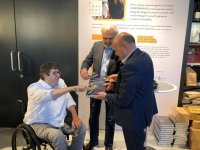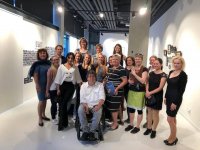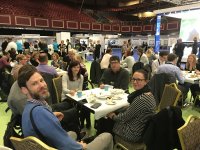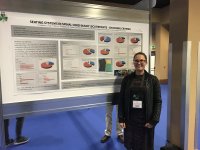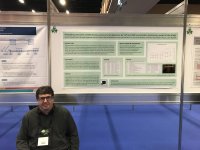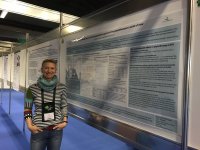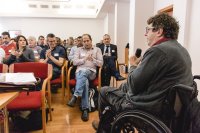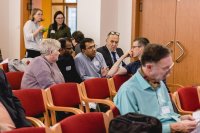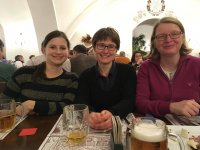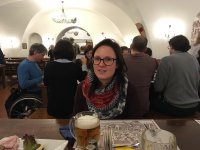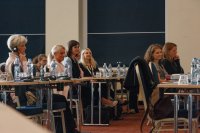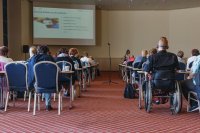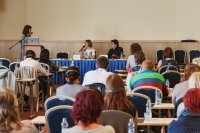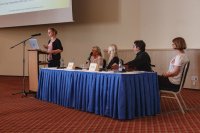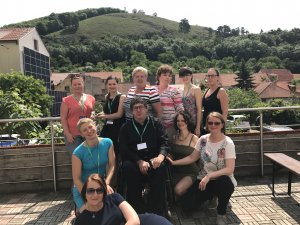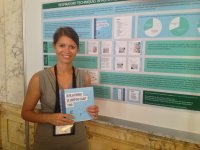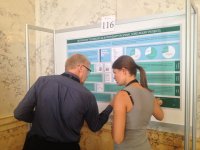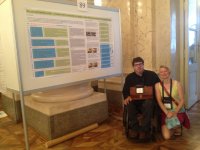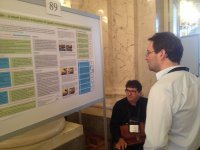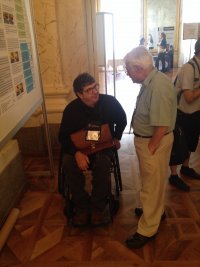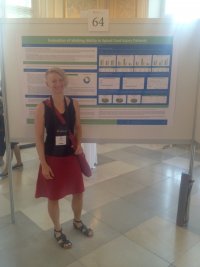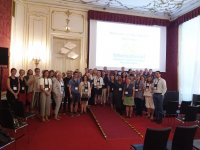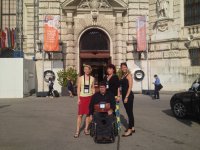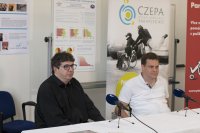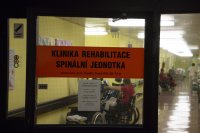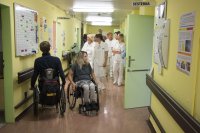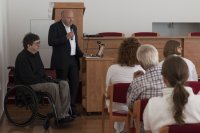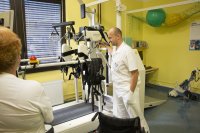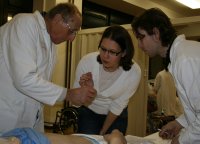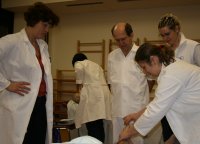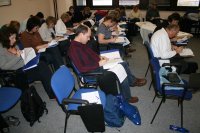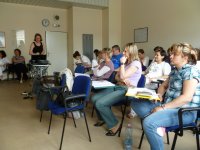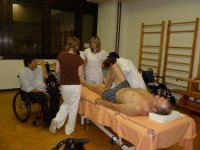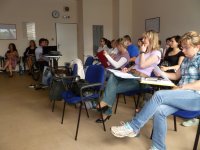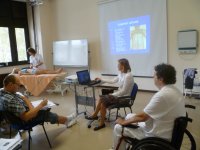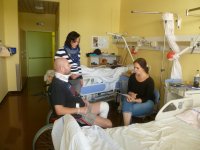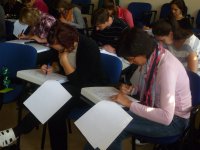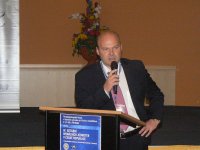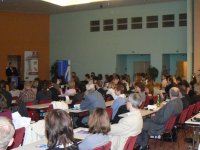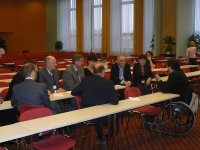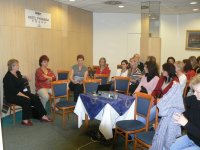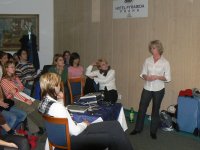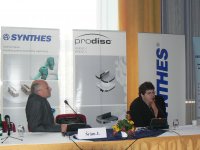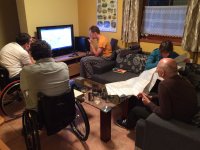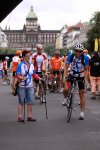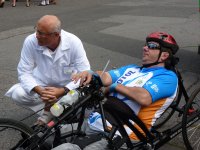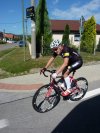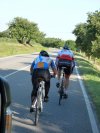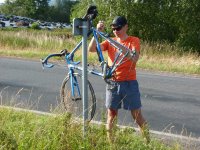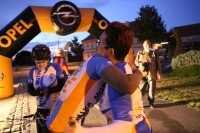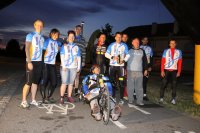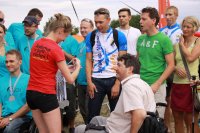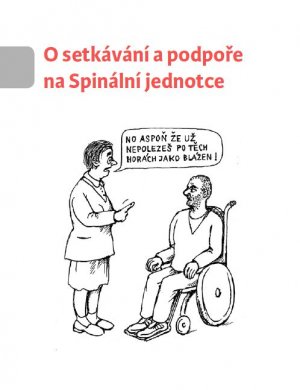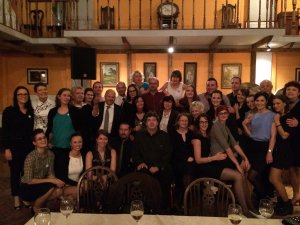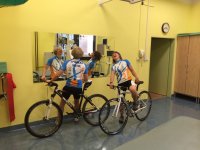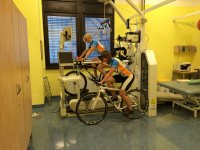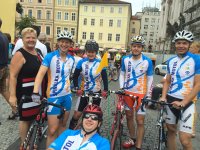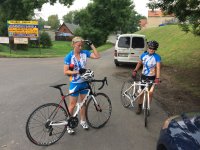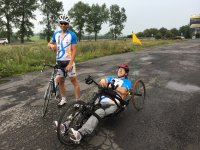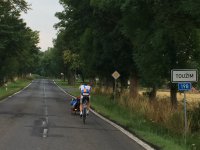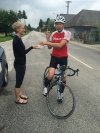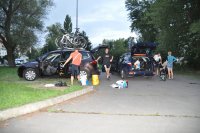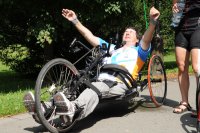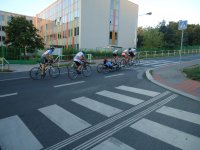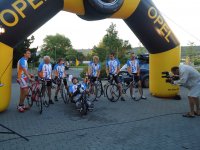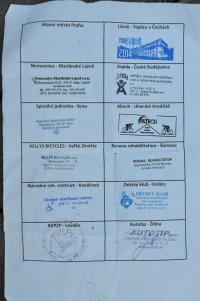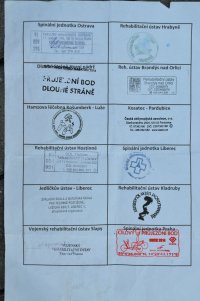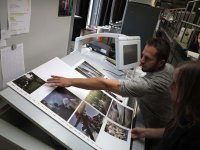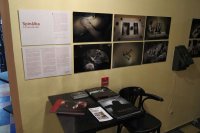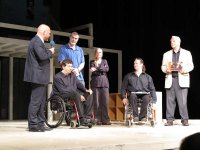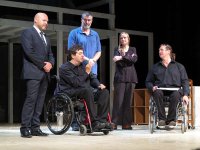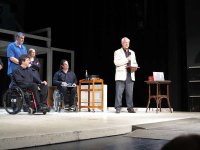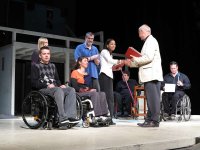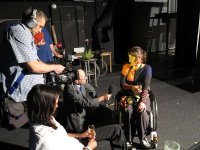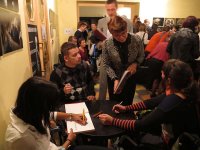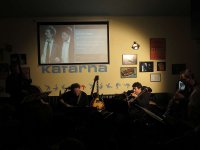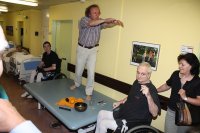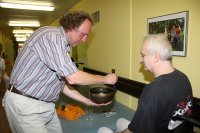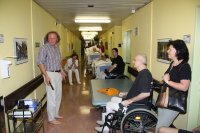- Basic information
- Management and personnel
- Bed part
- Outpatient department
- Devices in patient therapy
- Science and teaching
- Publications
- Events and seminars
- Social activities
- Links
- Contact
Basic information
The Spinal Unit is a department focused on providing comprehensive treatment, rehabilitation and nursing care for patients with spinal cord injuries. This most often occurs as a result of an injury, but acute damage to the spinal cord can also occur due to vascular, tumor, inflammation, demyelinating or other diseases. The spinal unit is intended for patients in the subacute and chronic stages of spinal cord injury. In the acute phase, patients are hospitalized in one of 15 specialized spondylosurgical and orthopedic departments, after surgery and stabilization of vital functions, they are usually transferred to the Spinal Unit after 1-2 weeks and after about 8-12 weeks to the Spinal Rehabilitation Unit of the Rehabilitation Institute. Around 250 patients after acute spinal cord trauma go through this system every year.
Patients in the chronic stage of spinal cord injury come to the spinal unit either in case of an acute deterioration of the health condition, or for hospitalization before and after planned surgical interventions.
There are a total of four spinal units in the Czech Republic, in addition to the Spinal Unit at the Rehabilitation and Physical Education Clinic of the University of Warsaw 2nd Faculty of Medicine and the Motol General Hospital, there is also the Spinal Unit at the Traumatology-Orthopedic Center of the Regional Hospital Liberec, a.s., and the Spinal Unit at the Trauma Surgery Clinic of the Brno FN - Bohunice and the Spinal Unit at the FN Neurosurgery Clinic with the Ostrava Polyclinic.
The Spinal Unit at the Rehabilitation and Physical Education Clinic of the 2nd Faculty of Medicine in Motola was opened on June 22.6. 2004. According to methodological measure 6/2002 of the Ministry of Health, it was included in the program of specialized care for patients with recent spinal injuries.
History of spinal units in the Czech Republic
Already in the 50s - 60s of the last century prof. Beneš sought to establish centers in which patients will be treated after spinal cord injury. Sir was his role model. Ludwig Guttmann, who founded the first such spinal center in the post-war years in Stoke Mandeville, England. The efforts of prof. Beneš failed due to the reluctance of the then ministerial officials. In the 90s, the so-called Spinal Program began to emerge. Prof. Wendsche, who in 1992 opened the first spinal unit in the Czech Republic in Brno. The establishment of the Czech Spondylochiurgical Society in 1999 was crucial for the effective implementation of the spinal program of the Czech Republic. This effort was crowned in 2002 with the issuance of the Methodological Measure of the Ministry of Health of the Czech Republic, which established a network of spinal units in our republic. On the basis of this Methodological Measure, other spinal units began to emerge in 2003-2004, gradually in Ostrava, Liberec and Prague-Motol.
Management and personnel
Knowledge
Primary:
doc. MD Jiří Kříž, Ph.D.
tel .: 22443 9207
Email: jiri.kriz@fnmotol.cz
Head nurse:
M.Sc. Hana Jirků
tel .: 22443 9208
fax: 22443 9221
Email: hana.jirku@fnmotol.cz
Medical team
Doctors:
MD Veronika Hyšperská
tel .: 22443 9253
Email: veronika.hysperska@fnmotol.cz
tel .: 22443 9253
Email: anna.lottmann@fnmotol.cz
MD Michal Schützner
tel .: 22443 9253
Email: michal.schutzner@fnmotol.cz
MD Zuzana Meisterová
tel .: 22443 9253
Email:zuzana.meisterova@fnmotol.cz
MUDr. Rybka Vojtech
tel .: 22443 9253
Email: vojtech.rybka@fnmotol.cz
Physiotherapists:
Jan Mikes, Dis. 
tel .: 22443 9284
Email: jan.mikes@fnmotol.cz
Bc. Kristýna Šedivá
tel .: 22443 9284
Email: kristyna.sediva@fnmotol.cz
Bc. Lenka Špačková
tel .: 22443 9284
Email: lenka.spackova@fnmotol.cz
M.Sc. Lenka Vinciková
tel .: 22443 9284
Email: lenka.vincikova@fnmotol.cz
M.Sc. Karolina Hrbáčková
tel .: 22443 9284
Email: karolina.hrbackova@fnmotol.cz
Bc. Terezia Šediva
tel .: 22443 9284
Email: terezia.sediva@fnmotol.cz
Occupational Therapists:
Bc. Alena Ulmanová
tel .: 22443 9293
Email: alena.ulmanova@fnmotol.cz
Bc. Balková Josefína
tel .: 22443 9284, 22443 9239
Email: josefina.balkova@fnmotol.cz
Nursing staff:
Station nurse and further in alphabetical order:
Eliška Daníčková, DiS.
tel .: 22443 9254
Email: eliska.danickova@fnmotol.cz
- Black Mary
- Jiří Homola, Dis.
- Hošková Kateřina, DiS.
- Bc. Charousová Kateřina
- Kynčlova Anna
- MA Masek Darina
- Little Denis
- Mohelníková Markéta
- Pokorný Pavel
- Sibrinová Kateřina
- Vasyl Roman
Sanitary:
- Zdenka Kabeláčová
- Khantya Ihor
- Frosty Dana
- Plocova Dora
- Tokaievskyi Edvard
Social counseling
Bc. Magda Vrabelová
tel .: 22443 1175
Email: magda.vrabelova@fnmotol.cz
Psychologist
M.Sc. Petra Kurkova
tel .: 22443 3488
Email: petra.kurcova@fnmotol.cz
Inpatient department
The spinal unit has 16 beds, including 2 intermediate care beds for spontaneously ventilating patients requiring monitoring. In the ward, patients have barrier-free sanitary facilities, 2 exercise rooms and a common room.
Rehabilitation on the spinal unit
The spinal unit provides intensive comprehensive rehabilitation care for patients with spinal cord injury. The department is equipped with all available aids and devices for the treatment and rehabilitation of patients with spinal cord injury.
Acute patient care
Physiotherapy
Due to the different needs of acute and chronic patients, their therapy differs. Acute patients undergo intensive rehabilitation. This is made up of individual physiotherapy, it is approximately 2 x 1 hour therapy sessions per day. Group exercises are added to individual therapy twice a week. Individual therapy is complemented by exercises on equipment - verticalization table or stand, motomed letto and motomed viva.
The physiotherapy plan includes kinesiotherapy, rehabilitation based on neurophysiology - Vojt's method, DNS concept - dynamic neuromuscular stabilization, Bobath concept, S-E-T concept, soft tissue mobilization and techniques, respiratory rehabilitation, active and passive exercises and others.
Occupational therapy
Occupational therapy is also an essential part of the rehabilitation of acute patients. Its aim is to help restore or regain the activities needed to carry out normal daily activities (e.g. dressing, breathing, ...) lost as a result of injury or illness. One of the important activities of an occupational therapist is the care of the upper limbs (hands), which we need to carry out normal daily activities.
The occupational therapist uses various activities, activities, adapted environments and compensatory aids for his therapy. It also helps patients choose these aids, always individually according to the patient's health condition and specific situation.
Care for chronic patients
The nature of the care for chronic patients is determined by the difficulties for which they were admitted to the Spinal Unit. Usually, the condition of chronic patients does not require or even do not allow for intensive rehabilitation and occupational therapy, hospitalization is aimed at examining and resolving health complications, or preparation for planned surgeries. If the patient's state of health or current situation so requires, he or she undergoes physiotherapy or occupational therapy targeted at existing problems.
Good to know for hospitalization on the spinal unit
Room equipment
The rooms are equipped with adjustable beds with anti-decubitus mattresses. Each bed has several options for signaling to the nursing staff (electric bells, voice sensors or specially modified signaling devices for patients with impaired mobility of the upper limbs).
Patients in the ward are hospitalized in double rooms, which are equipped with television, they can of course make full use of their own electronic devices. If the patient's medical condition does not allow him to control his mobile phone, the nursing staff will be happy to help him. In this case, it is also advisable to have a hands-free accessory that allows you to control your phone by voice. In our department it is possible to use a wireless internet connection.
What a patient needs to stay on the spinal unit
Among the basic things that the patient will need during their stay with us are hygiene items and comfortable, loose clothing for exercise - T-shirt, tight shorts and long pants, sports shoes preferably one size larger.
What relatives and loved ones should know
Visiting hours on the ward are from 9:30 to 20:30. Patients have a planned rehabilitation and treatment program, so it is necessary to agree with the patient in advance on the appropriate timing of visits. In some cases, visits may be present during rehabilitation.
Health information they will be given only to the persons indicated by the patient in the admission documentation. It is not possible to provide information by telephone without prior agreement. Security when communicating information is secured with a password.
Consultation with the attending physician they are possible by prior arrangement during working hours from 7:00 to 15:00, in individual cases the consultation can be carried out even after working hours in the afternoon service.
Outpatient department
Doctor's clinic
The spinal unit includes a specialist medical clinic, which provides outpatient care for patients with spinal cord injuries and their dispensary.
The outpatient clinic provides dispensary and supraconciliar care for patients in the chronic phase of spinal cord injury, focusing on the specific problems of these patients, but does not aim to replace regular examinations by general practitioners and outpatient specialists. The outpatient examination takes approximately 60 minutes.
In the event that you travel to us by ambulance, we will issue an order for the return journey to our department after the examination.
Order on the phone number: 224 439 253, 224 439 255, 224 439 207.
Ambulance office hours:
MON 10:00-13:00 primary doc. MD Kříž Jiří, Ph.D.
TUE 8:00-15:00 MUDr. Renata Háková
WED 8:00-15:00 MUDr. Hyšperská Veronika
TH 10:00-13:00 primary doc. MD Kříž Jiří, Ph.D.
FRI 8:00-14:00 MUDr. Hyšperská Veronika
Physiotherapist clinic
In agreement with the doctor, it is possible to complete the series on an outpatient basis in the indicated cases individual physiotherapy. The number of visits and the duration of physiotherapy depends on the individual agreement and the needs of the patient. Frequencies, specific dates and times are also determined individually, in agreement with the physiotherapist
Occupational therapy clinic
In agreement with the doctor, it is possible to complete the series on an outpatient basis in the indicated cases individual occupational therapy. The number of visits and the duration of occupational therapy depends on the individual agreement and the needs of the patient.
Devices in patient therapy
Pablo®
Pablo's device® used for robotic and computer diagnostics and hand therapy. It contains a wide range of therapeutic games, through which it is possible to strengthen the muscles of the hand and the entire upper limbs, train the coordination of the upper limbs and thus improve the overall function of all segments of the upper limbs. The Pablo device is possible in diagnostics® used to measure grip muscle strength and measure the range of motion of the hand joints. Therapy can also focus on training attention, cognitive and fatal functions.
The device can be used in the treatment of subacute and chronic patients
Examination options
The device is able to measure the isometric strength of grips, the active range of motion of the joints of the arm and hand.
Possibilities of use for therapy
Using the Pablo device® the active functions of the hand and arm can be practiced and re-educated through various purposefully designed interactive therapeutic games. Cognitive and phatic functions can also be trained using therapeutic games.
For whom therapy is not suitable
Therapy is not suitable for patients with orthostatic circulatory problems, unstable fractures, patients with severe osteoporosis, skin problems, if the patient is unable to actively cooperate, if the device cannot be adjusted correctly, severe spasticity (MAS 4), patients with apraxia and neglect syndrome, pain, swelling, arthritis of the wrists and fingers, in patients with a pacemaker
MOTOmed®
therapeutic movement device for passive and active cyclic movement of the lower and upper limbs.
Verticalizing table
treatment device for gradual verticalization from lying down to standing
Verticalizing stand
medical device for verticalization from sitting to standing
Redcord®
rehabilitation aid for exercises on hanging ropes based on S.E.T. concept.
Further:
aids for verticalization, positioning, mechanical carts, jacks, overballs, unstable platforms, Therabandy, Flexi-bar
devices for physical therapy (thermotherapy, hydrotherapy, phototherapy, electrotherapy), aids for respiratory rehabilitation
Devices used in the treatment of pressure ulcers
VAC device and treatment system
The VAC (vacuum assisted closure) device and treatment system is a new method of treating problematic wounds, including soft tissue defects in open fractures. The principle is to create a negative pressure under the foil covering the wound, which helps the continuous drainage of interstitial fluid from the wound, reduces bacterial colonization, accelerates the formation of granulation tissue. This significantly shortens the preparation time of the substrate for the final wound covering and the total treatment time.
Misonix SonicOne
Misonix SonicOne is a modern device that improves wound care. It is used in the first phase of wound healing - in the preparation of the wound bed.
Effects and goals of therapy
Successful removal of dead tissue (debridement) and no longer nourished tissue from the wound is a necessary first step in wound healing. SonicOne is different from other systems in that it facilitates extremely thorough debridement with minimal pain perception and excellent maintenance of healthy soft tissues. The built-in adjustable rinsing system allows dead cells, bacteria and inflammatory effusion to be more easily removed from the wound site, as an important element in wound cleaning.
Clinical experience with SonicOne shows that the wound is cleaned faster and the so-called granulation of its base, on which healing can then continue successfully. All this with significantly reduced bleeding and traumatization of the remaining tissue.
The principle of the device
The SonicOne generator converts a standard mains voltage to a 22,5 kHz electrical signal. The manual part uses high-efficiency piezoelectric crystals to convert the electrical signal into mechanical vibrations. The titanium alloy probe amplifies mechanical vibrations and transmits acoustic energy to the tissue through direct contact. The resulting mechanical and hydrodynamic effects cause the disruption of dead tissue, its further fragmentation and emulsion at the base of the wound.
Use of the device
The design of each SonicOne probe allows for efficiency in different tissue types. Clinical uses include diabetic lower limb ulcers, venous ulcers, pressure ulcers (bedsores) and burns. In our department, the device is used mainly in the treatment of pressure ulcers, both in hospitalized patients and in patients coming to the outpatient department.
Science and teaching
EMSCI - multicenter international database
EMSCI - Establishing a multi-center basis for future therapeutic interventions in human spinal cord inj
This is a multicenter study prepared and organized by the Balgrist Hospital Paraplegic Center in Zurich, Switzerland. The main researcher is prof. Dr. Volker Dietz. The aim of this study is to create a multicenter database for future therapeutic interventions in patients with spinal cord injury. Patients with spinal cord injuries with spinal cord injuries are included in the study. They are tested at regular intervals. There are four areas of examination. These are neurophysiological examinations, neurological examinations according to ASIA, functional tests and independence test. The purpose of the study is to standardize the procedures for conducting these tests and to collect as much anonymous data as possible. These are sent to the coordination center in Zurich and included in the central database.
Sponsor: International Foundation for Research in Paraplegia, Zurich
17 centers participate in the creation of the database, which work closely together in the implementation of prospective studies focused on:
- the relationship between electrophysiological, neurophysiological and functional examinations
- the prognostic value of the test results
- healing mechanisms
- research into new treatments
NISCI study
The FNM Spinal Unit is one of the partners of the international European project NISCI (Nogo Inhibition in Spinal Cord Injury). The aim of the study is to verify whether early intrathecal administration of antibody therapy can improve the movement and quality of life of tetraplegic patients after spinal cord trauma. More information about the study: https://nisci-2020.eu
- Discontinued 2023
Voice Assistant pilot project
A pilot project is underway at the spinal unit, which deals with the use of a voice assistant with artificial intelligence. The subject of this pilot project is to verify the maturity of this technology and find suitable ways to use it to improve the quality of life of patients with spinal cord injury in institutional and home care.
The first phase of the project focused on the usability of the technology itself. Developments in the field of artificial intelligence have made significant progress in recent years, which, together with the miniaturization and growth of processor performance, advances in self-targeting surround microphones and the development of the so-called Internet of Things, has enabled the emergence of smart voice assistants. This technology is very affordable today. In addition, in many respects, earlier assistive technologies outperform both user and functionality.
Patients in the spinal unit go through a difficult period in the initial phase, when they begin to fully feel the effects of loss of self-sufficiency and, consequently, social separation. Patients with upper limb paralysis (tetraplegics) are testing this technology. These people rely on the help of another person, and initially almost everyone. The possibility of telephoning with family and loved ones, calling and remote communication with medical staff and increasing self-sufficiency in controlling the environment, such as television or light, increases the quality of life during hospitalization right from the start.
The next step was to establish cooperation with technological partners and manufacturers of medical beds for the development of a prototype control of the position of the medical bed. The first version of the prototype now provides patients with predominant paralysis of all four limbs to test the possibility of positioning the bed by voice.
Pilot project partners:
- Foundation movement without help
- Deepview
- Hardware
- Linette
- PetMAT
- Smíchov Secondary Industrial School
Undergraduate teaching
2nd Faculty of Medicine, Charles University
1st year NMgr. physiotherapy - Methodical procedures in the work of a doctor - spinal unit
3rd year Bc. physiotherapy - Physiotherapy on the spinal unit
4th year medici - Problems of medical rehabilitation in the spinal unit
Medici angl. - Rehabilitation in patients after SCI, Rehabilitation in orthopedic medicine
Clinical practice of students Bc. and NMgr. physiotherapy
3rd Faculty of Medicine, Charles University
3rd, 4th, 5th and 6th year
Spinal cord injury - spinal program, Soft knee injury, Rehabilitation after spine injury, spinal program for spinal cord injury
Medici angl. - Rehabilitation after spinal trauma, spinal program in paraplegia
Postgraduate teaching
Pre-certification course Rehabilitation in neurology - spinal cord injury
Vojta's method course - Patient after spinal cord injury, stages, treatment, possibilities of physiotherapy
Publications
Kriz J. et al. Spinal cord injury - Causes, consequences, organization of care. Galen 2019. ISBN 9788074924248
http://www.galen.cz/idistrik/vydav/?page[book]=5791
Expected functional results in motorized complete spinal cord lesions. Spinal unit at the Department of Rehabilitation and Sports Medicine, 2nd Medical Faculty, Charles University and University Hospital in Motol 2018.
Brochures
Load in relief or exercise with pressure ulcers. Spinal unit at the Department of Rehabilitation and Sports Medicine, 2nd Medical Faculty, Charles University and University Hospital in Motol 2019.
Breathing must also be taken care of. Spinal unit at the Department of Rehabilitation and Sports Medicine, 2nd Medical Faculty, Charles University and University Hospital in Motol 2016.
Exercise at home - tetraplegia. Spinal unit at the Department of Rehabilitation and Sports Medicine of the 2nd Medical Faculty of Charles University and the University Hospital in Motol in cooperation with the Czech Association of Paraplegics - CZEPA 2014.
About meeting and support at the Spinal Unit. Spinal unit at the Department of Rehabilitation and Sports Medicine, 2nd Medical Faculty, Charles University and University Hospital in Motol 2014.
And life goes on ... Spinal unit at the Department of Rehabilitation and Sports Medicine, 2nd Medical Faculty, Charles University and University Hospital in Motol 2012
Posters
On Spinal cord Injury Day 2016, the Spinal Unit team created a set of posters that describe the basic areas of spinal patient care from the perspective of individual professions.
On the same occasion, Spinal Injury Day, a conference on Prevention and Early Treatment of Pressure ulcers in patients with spinal cord injury was held on September 4, 2017, organized by the FNM Spinal Unit. At the same time, this poster was created on the topic, which is also available in printed form in the form of a leaflet at the Spinal Unit.
Chapters in foreign monographs
Bodine C, Chen Y, Chhabra H, Donovan W, D'Andrea Grepe J, Jessup N, Kiekens C, Kim S, Kriz J, Li J, Li L, Lukersmith S, Marshall R, Office A, Purves S, Qu H , Vogel L, Per von Groote M, Waring W, Webel J, Weerts E. Chapter 5: Health systems strengthening. In: Bickenbach J. et al. (eds.) International Perspectives on Spinal Cord Injuries. World Health Organization 2013: 93-120. ISBN 978-92-4-156466-3
http://apps.who.int/iris/bitstream/10665/94190/1/9789241564663_eng.pdf
Cross J. Spinal cord injury. In: Kolář P et al. (eds). Clinical rehabilitation. Rehabilitation Prague School. 2013: 384-389. ISBN 978-80-905438-0-5
Kriz J, Hysperska V. Spinal cord syndromes. In: Kolar P et al. (eds). Clinical rehabilitation. Rehabilitation Prague School. 2013: 85-86. ISBN 978-80-905438-0-5
Chapters in Czech monographs
Cross J. Spinal cord diseases. In: Tomek A. et al. (eds.) Neurointensive care - a practical guide. Prague: Mladá fronta, Edition of postgraduate medicine 2012: 403-420. ISBN 978-80-204-2659-8
Cross J. Spinal cord lesions. In: Vacek J, Jandová D (eds.) Manual of rehabilitation and physical therapy. 1st ed. , Prague, Raabe. 2012: B4 / 1-24. ISSN 1805-0417
Cross J. Spinal cord damage. In: Kolář P et al. (eds). Rehabilitation in clinical practice. 1st ed., Prague, Galén. 2010: 352-356. ISBN 978-80-7262-657-1
Kriz J, Hysperska V. Spinal syndrome. In: Kolář P et al. (eds). Rehabilitation in clinical practice. 1st ed., Prague, Galén. 2010: 80-81. ISBN 978-80-7262-657-1
Works published in professional journals - abroad
Kriz J, Relichova Z. Intermittent Self-catheterization in Tetraplegic Patients - A Six-Year Experience Gained in the Spinal Cord Unit in Prague. Spinal Cord 2013; in press. ISSN 1362-4393
http://www.nature.com/sc/journal/vaop/ncurrent/full/sc2013154a.html
Kriz J, Andel R, Hakova R. Delayed diagnosis of an unsuspected pelvic fracture in a patient with tetraplegia. J Spinal Cord Med. 2013; in press. ISSN 1079-0268
Kriz J, Kozak J, Zedka M. Primary motor cortex inhibition in spinal cord injuries. Neuro Endocrinol Lett. 2012;33(4):101-111. ISSN 0172-780X
Van Middendorp JJ, Pouw MH, Hayes KC, Williams R, Chhabra HS, Putz C, Veth R, Geurts A, Aito S, Kriz J, McKinley W, van Asbeck F, Curt A, Fehlings MG, Van de Meent H, Hosman AND; EM-SCI Study Group. Diagnostic criteria of traumatic central cord syndrome. Part 2: A Questionnaire Survey among Spine Specialists. Spinal Cord 2010; 48 (9): 657-663. ISNN 1362-4393
http://www.nature.com/sc/journal/v48/n9/full/sc201072a.html
Van Hedel HJA, Dietz V, Meiners T, Benito J, Abel R, Meindl R, Marcus O, Röhl K, Thietje R, Gerner HJ, Harms J, Potulski M, Maier D, Duysens J, Bussel B, Kriz J, Al -Khodairy A, Kaps HP, Kalke YB. Walking during daily life can be validly and responsibly assessed in subjects with a spinal cord injury. Neurorehabil Neural Repair 2009; 23(2): 117-124
Works published in professional journals published in the Czech Republic
Kriz J, Hlinkova Z. Neurorehabilitation of sensorimotor functions after spinal cord injury. Cesk Slov Neurol N 2016; 79/112 (4): 378-394.
Cross J. Spasticity after spinal cord injury. Rehabil. Léč., 22, 2015, No. 3, pp. 128-135.
Cross J, Hlinková Z, Slabý K. Changes in metabolism after spinal cord injury. Part 1: Differences in body composition and metabolic consequences. DMEV. 2014; 17(4): 209-213.
http://www.tigis.cz/images/stories/DMEV/2014/04/kriz.pdf
Kriz J, Hlinkova Z. Changes in metabolism after spinal cord injury. Part 2: Possibilities of influencing energy expenditure by physical activity. DMEV. 2017; 20(2): 88-93.
http://www.tigis.cz/images/stories/DMEV/2017/02/DMEV_2_2017_Kriz.pdf
Hlinkova Z., Joachimova M., Kriz J. Changes in metabolism after spinal cord injury. Part 3: Possibilities of influencing energy intake. DMEV. 2017; 20(3): 152-156.
http://www.tigis.cz/images/stories/DMEV/2017/03/DMEV_Clanek_3_2017_Hlinkova.pdf
Kříž J, Háková R, Hyšperská V, Hlinková Z, Lukáš R, Andel R. International Standards for Neurological Classification of Spinal Cord Injury - Revision 2013. Cesk Slov Neurol N 2014; 77/110 (1): 77-81.
Kriz J, Rejchrt M. Autonomic dysreflexia - a serious complication in patients after spinal cord injury. Cesk Slov Neurol N 2014; 77/110 (2): 168-173.
Kriz J, Hysperska V. Development of neurological and functional image after spinal cord injury. Cesk Slov Neurol N 2014; 77/110 (2): 186-195.
Cross J, Kafunkova P, Schreier B, Kolar P. Suspended locomotion training in patients after spinal cord injury. Czech Words Neurol N. 2010; 73 (2): 124-130. ISSN 1210-7859
Reviewed publications
Kriz J, Hlinkova Z. Respiratory complications in patients after spinal cord injury and their solution at the Motol University Hospital Spinal Unit. Rehabilitation and physical medicine 2014, year. 21, No. 1, pp. 16-20.
Cross J. Spinal program in the Czech Republic - history, present, perspectives. Neurol. practice 2013; 3: 140–143. ISSN 1213-1814
http://www.neurologiepropraxi.cz/pdfs/neu/2013/03/07.pdf
Kriz J, Hysperska V. Risk conditions in patients in the chronic phase after spinal cord injury. Neurol. practice 2009; 10 (3): 137-142. ISSN 1213-1814
http://www.neurologiepropraxi.cz/pdfs/neu/2009/03/03.pdf
Kriz J, Chvostova S. Examination and rehabilitation procedures in patients after spinal cord injury. Neurol. practice 2009; 10 (3): 143-147. ISSN 1213-1814
http://www.neurologiepropraxi.cz/pdfs/neu/2009/03/05.pdf
Hysperska V, Kriz J. Diagnosis and treatment of pain in patients after spinal cord injury - our experience. Neurol. practice 2009; 10 (3): 153-159. ISSN 1213-1814
http://www.neurologiepropraxi.cz/pdfs/neu/2009/03/06.pdf
Oplatkova L, Kriz J. Medical rehabilitation at the spinal unit in the Motol University Hospital. Sanquis 2006; 47: 22-25. ISSN 1212-6535
http://www.sanquis.cz/index1.php?linkID=art207
Unreviewed publications
Kriz J, Faltynkova Z. Treatment and rehabilitation of patients with spinal cord injuries - a guide for general practitioners. Czech Association of Paraplegics with the support of the Ministry of Health of the Czech Republic 2013.
http://www.czepa.cz/news/edukacni-materialy-publikace/
Cross J. Care at the Spinal Unit of the University Hospital in Motol. Helios 2013; 1:4–5.
Cross J. Dangerous spinal cord injuries. Medical newspaper 2010; 59 (22) (Patient sheets): 22–24. ISSN 1805-2355
Kříž J. A doctor's view of the benefits of a hospital clergyman. Diagnosis in nursing 2010; 6 (5): 41. ISSN: 1801-1349
http://www.promediamotion.cz/wp-content/uploads/2011/03/DG_05_10.pdf
Kriz J, Kozak J. Recommended procedures for classification and treatment of pain in patients after spinal cord injury. Association of Paraplegics with the support of the Ministry of Health of the Czech Republic 2006.
http://www.spinalcord.cz/cz/publikace/
Kriz J, Spanhelova S. Rehabilitation of patients after spinal cord injury. Medical newspaper 2005; 54 (29) (Medical sheets - Rehabilitation): 6-7. ISSN: 1805-2355; 1214-7664
Cross J. Recommended procedures for the management of autonomic dysreflexia in patients after spinal cord injury. Association of Paraplegics with the support of the Ministry of Health of the Czech Republic 2005.
http://www.spinalcord.cz/cz/publikace/
Wendsche P, Kriz J. Recommended care procedures in the acute phase after spinal cord injury. Association of Paraplegics with the support of the Ministry of Health of the Czech Republic 2005.
http://www.spinalcord.cz/cz/publikace/
Faltynkova Z, Kriz J, Kabrtova A et al. The road to independence after spinal cord injury. Paraplegic Association 2004.
http://vozejkov.cz/temp/publikace/Cesta-k-nezavislosti-web.pdf
Abstract
Fousova J, Kafunkova P, Kriz J. Our experiences with shoulder pain in patients after spinal cord injury. 16th European Congress of Physical and Rehabilitation medicine, June 3–6, 2008, Brugge, Belgium. J Rehabil Med 2008; Suppl 47: 278. ISSN 1650-1977
Zedka M., Kriz J. Magnetic stimulation predicts clinical recovery after spinal cord injury. Abstracts of the 17th Conference on Posture and Gait Research, Marseille, May 29th-June 2nd, 2005. Gait and Posture 2005; 21, Suppl 1: S74. ISSN 0966-6362
Works published in peer-reviewed proceedings published abroad
Kriz J. Evaluation of electronic forms for neurological and functional assessment after spinal cord injury. Abstract book. 52nd ISCoS Annual Scientific Meeting, October 28-30, 2013, Istanbul, Turkey.
Kriz J, Sulc, J. Monitoring of respiratory dysfunctions after traumatic spinal cord injury. Abstract book p.407. 51st ISCoS Annual Scientific Meeting, September 3-5, 2012, London, UK.
Kriz J, Hysperska V. Neuropathic pain management in patients after Spinal Cord Injury. Abstract book p.55. NoSCoS Congress, June 3-6, 2009, Viborg, Denmark.
Kriz J, Kolar P, Oplatkova L, Fousova J, Hysperska V, Kobesova A. Physiotherapy in Patients with Spinal Cord Lesions at First Place. Abstractbook p.336. 46th ISCoS Annual Scientific Meeting, June 27-30, 2007, Reykjavík, Iceland.
Papers published in peer-reviewed proceedings published in the Czech and Slovak Republics
Hysperska V, Kriz J. Physical activity in humans after spinal injury. in. Proceedings abstract: p. XVII. Congress of the Society of Rehabilitation and Physical Medicine. Luhačovice, 14.-15. May, 2010. ISBN 978-80-254-7092-3.
Kriz J, Kafunkova P. RT300 system and its use. in. Proceedings abstract: p. XNUMXth Congress of the Society of Rehabilitation and Physical Medicine. Luhačovice, 15.-16. May, 2009, Luhačovice
Chvostova S., Kriz J. Rehabilitation in tracheostomized patients after spinal cord injury. in. Proceedings abstract: p. XNUMXth Congress of the Society of Rehabilitation and Physical Medicine. Luhačovice, 15.-16. May, 2009.
Hysperska V, Kriz J, Oplatkova L. Rehabilitation of patients after spinal cord injury. pp. 6. XIV. Congress of the Society of Rehabilitation and Physical Medicine. Luhačovice, 13.-14. April, 2007. ISBN 978-80-239-8744-7
Rejchrt M, Hyrsl L, Hysperska V, Kriz J. Evaluation of urological treatment results in patients after spinal cord injuries. in. Proceedings abstract: Annual conference of the Czech Urological Society ČLS JEP. České Budějovice, October 11-13.10.2006, 2006 Nucleus HK, 123, pp. 80. ISBN 87009-10-XNUMX-X
Events and seminars
Book launch Spinal cord injuries - Causes, consequences, care organization
On May 30, 5, we celebrated with joy and a little relief the publication of a book summarizing the issue of spinal cord injury. Under the guidance of the main author of the book, the co-authors and those who helped the author with the writing met in Prague - Nový Butovice. Thanks everyone and good luck with the book!
http://www.galen.cz/idistrik/vydav/?page[book]=5791
56th ISCoS Annual Scientific Meeting
24 - 26 October 10, Dublin
Representatives of the Spinal Unit of the University Hospital in Motol also took an active part in this year's international congress organized by The International Spinal Cord Society (ISCoS). On three posters, we presented our experience in the field of medical, physiotherapeutic and occupational therapy care for patients after spinal cord injury. As always, the congress was a source of a lot of new knowledge and professional inspiration for us.
NISCI Investigators' Training
29 - 30 November 11, Prague
As one of the partners, the Spinal Unit of the University Hospital in Motol participates in the EU grant project Antibodies against Nogo-A for increasing plasticity, regeneration and recovery of function after acute spinal cord injury - NISCI. This is a multicenter, international, placebo-controlled study that aims to enhance CNS regeneration after acute spinal cord injury by intrathecal administration of an anti-Nogo-A monoclonal antibody.
In the FN in Motola, it took place on the 29th - 30th. 11. 2017 international training of investigative experts of all specialties who will participate in the study. The inclusion of the first patients in the NISCI clinical trial is expected in the second half of 2018.
Physiotherapy course for patients with spinal cord lesions
3 - 5 November 2017
In cooperation with the Paraple ops Center, the first course in Physiotherapy for patients with spinal cord lesions took place this year. The course was intended for all physiotherapists who would be helped by inspiration in working with wheelchair users, what can be done, what goals one can draw and what limits one can meet.
All important information can be found on the course website: https://kurz.spinalcord.cz/
Prevention and early treatment of pressure ulcers in patients with spinal cord injury
4. September 2017
On September 4, 2017, a professional conference entitled "Prevention and early treatment of pressure ulcers in patients with spinal cord injury" took place at the Orea Hotel Pyramida in Prague 6 with international participation. The conference was organized on the occasion of the International Day of Spinal Cord Injuries
Spinal unit at the RHB and TVL Clinic of the 2nd Medical Faculty of Charles University and the University Hospital in Motol with grant support from the Norwegian Funds from the Bilateral Cooperation Fund. The conference was intended for professionals who may be in first contact with chronic patients after spinal cord injury who have developed a new pressure ulcer. The main goal was to acquaint the participants with the correct treatment procedure, which is a necessary prevention of the development of very serious later complications. The experience of Czech and Norwegian specialists who have been dealing with the issue for a long time was presented.
X. professional conference and meeting of spinal units
1 - 2 June 6, Mikulov
In June, a traditional conference focused on the issue of spinal patients took place. Its main topic was "multidisciplinarity of spinal care" and in individual conference blocks space was devoted to medical, physiotherapeutic, occupational therapy, nursing and this year, compared to previous years, also relatively broadly psychological and social issues. The whole conference was closed by a panel discussion on the prevention, incidence and treatment of pressure ulcers, which are currently a very burning issue in the care of chronic patients in the Czech Republic.
The entire conference program can be found here: http://www.symma.cz/sj/
The spinal unit actively contributed with 7 oral lectures, 2 e-posters and 1 poster. Representatives of the spinal unit also actively participated in the final panel discussion. Of course, there can be no doubt about active participation in corridor discussions and social evenings 🙂
55th ISCoS Annual Scientific Meeting
14 - 16 September 2016, Vienna
In September, a group of five representatives of the spinal unit took part in an international conference dedicated to the issue of spinal cord injury. The conference in Vienna's Hofburg was organized by The International Spinal Cord Society (ISCoS). The comprehensive program of the conference covered a very wide range of topics related to the care of spinal patients. In addition to the lectures and lessons, there was also a poster section, to which the Prague Spinal Unit made a significant contribution. Through four posters, we presented the results of our long-term work with hospitalized as well as chronic outpatients. We also actively participated in meetings of professional working groups that work together under the auspices of ISCoS.
Spinal cord injury day September 5
International Society for Spinal Cord Lesions (ISCoS) decided, on a proposal from its Preventive Committee, to set up on 5 September On the day of spinal cord injury . The aim is to help raise awareness among the general public, thus facilitating the inclusion of people with disabilities and at the same time helping to ensure that prevention programs are more successful.
The day of spinal cord injury was accompanied by events in facilities in the Czech Republic involved in the care of spinal patients. Information about this day, the programs of individual facilities, but also, for example, the incidence of spinal cord lesions can be found at www.sciday.cz
An open day took place on September 5, 2016 at the Spinal Unit of the University Hospital in Motol. The department was guided by the medical staff of the spinal unit, but especially by our former patients, who enriched us all with their observations and for which they deserve our great thanks. On this day, the doctors, nurses, physiotherapists and occupational therapists of the spinal unit also presented comprehensive care for spinal patients in a short seminar.
You can see a short video on how the Spinal Unit Injury to the Spinal Unit took place at the link below.
https://www.youtube.com/watch?v=2rMCHHKydew
Spinal patient examination course
Since 2010, the Spinal Unit has been organizing spinal patient examination courses. The first course was held at the Department of Rehabilitation and Sports Medicine on January 8 and 9, 2010, followed in 2012, 2013, 2015 and 2016.
The courses are intended for doctors, physiotherapists and occupational therapists working with patients after spinal cord injury. The content of the courses are specific internationally recognized examinations of spinal patients, which are considered an essential part of the examination protocol for patients in the acute and chronic phase of spinal cord injury:
- ISNCSCI - International Standards for Neurological Classification of SCI - neurological examination to determine the neurological height of the lesion and the extent of the lesion
- SCIM - Spinal Cord Independence Measure - self-sufficiency testing
- walking tests - quantitative examination of walking
The structure of the course includes a theoretical part in which the participants get acquainted in detail with the implementation of the mentioned examinations and their evaluation. In the following practical part, each participant has the opportunity to try all examinations on a specific patient with a spinal cord injury.
Spinal patient examination course 2010
Spinal patient examination course 2012
Spinal patient examination course 2013
Spinal patient examination course 2015
Spinal patient examination course 2016
Spinal patient examination course 2017
Meeting of Spinal Units of the Czech Republic
Meetings of Spinal Units and Spinal Rehabilitation Units of the Czech Republic have been held regularly since 2004. In 2009, this meeting was common for the spinal units of the Czech and Slovak Republics. The meetings were previously held under the auspices of the Paraplegiological Forum, now under the auspices of the Czech Society for Spinal Cord Lesions.
The congress program is always divided into several thematic blocks, the topics of which respond to current trends in the care of spinal patients. Papers are presented by doctors, physiotherapists, occupational therapists, speech therapists, psychologists and general nurses working in spinal units, spinal rehabilitation units, spondylosurgery, neurosurgery, urology or rehabilitation facilities in the Czech and Slovak Republics, as well as representatives of non-profit organizations such as Centrum Paraple, Paracentrum Fénix and CZEPA. Former wheelchair users also share their experiences on the forum. Representatives of pharmaceutical companies and companies with medical devices also take part in spinal unit meetings.
I. Meeting of Spinal Units in Hradec nad Moravicí
organized by the Hrabyně Rehabilitation Institute, r. 2004
II. Meeting of Spinal Units in Liberec
organized by the Trauma Center with the Spinal Unit of the Liberec Regional Hospital, 6 - 8 October 10
III. Meeting of Spinal Units in Brno
organized by the Trauma Hospital in Brno, 9 - 10 November 11
IV. Meeting of Spinal Units in Prague
organized by the Faculty Hospital in Motola, 25 - 26 October 10
V. Meeting of Spinal Units in RÚ Kladruby
organized by RÚ Kladruby, 2 - 3 October 10
VI. Meeting of Spinal Units in Kováčová
organized by NRC Kováčová, SVK, 1 - 2 October 10
VII. Meeting of Spinal Units in Seč
organized by Hamz's specialist treatment center for children and adults Luže-Košumberk, 16 - 17 June 6
VIII. Meeting of Spinal Units Ostrava
organized by the Spinal Unit at the FN Neurosurgery Clinic with the Ostrava Polyclinic, 16 - 17 June 6
EMSCI - Annual membership meeting, Prague, July 3th 2009
In June 2009, the annual meeting of European spinal centers cooperating on a joint project of a European database of patients with spinal cord injuries took place at the Motol University Hospital. During the one-day conference, the results so far were evaluated, with the participation of leaders, scientists and researchers from 17 centers, and a discussion was held on the further direction of research plans. Current research was also presented, such as research on biomarkers of spinal cord injury, evaluation of validity and prognostic significance of MEP monitoring in lower limbs in patients with spinal cord injury, assisted robotic rehabilitation of upper limb in tetraplegics, research on biological treatment of spinal cord injury using Nogo protein and others. The workplace applying for membership in EMSCI - Spinal Center in Glasgow, Ireland was introduced. After the end of the professional program, the participants were invited to a social evening with a music program. The next day, a tour of Prague was organized for those interested
Social activities
Opel Handy Cyklo Marathon 2015
The last week of July saw the third edition of the Opel Handy Cyclomarathon, a team race around the Czech and Slovak Republics. Just like last year, this year the Spinálka Motol team proudly stood at the start to fly a course of approximately 4 km in 2222 days. Spinal surgeons from Motol, physiotherapists from Motol and a few of our cycling friends from Motol raced for their lives, and this year the head of the Spinal Unit sat at the head of the team.
Even in its third year, this race has retained its main idea, which is that disabled and "healthy" athletes take part in one team. In addition, each team has its own patron - a disabled person, whose participation the team wants to support. However, the patron of Spinálka Motol, our former patient Martina Dvořáková, was definitely not going to play a passive role, she strongly encouraged us throughout the race and was our biggest fan.
The Spinálka Motol team completed the entire race this year in a time of 87 hours 15 minutes and with this time ranked 16th. Although we did not achieve first place in the race, that was not really the point. Experiencing the atmosphere of such a specific race, pushing yourself to the limit and arriving back happily was amazing in itself. And to see the enthusiasm in the eyes of the patron Marti, whose legs and arms are not yet good enough for the bike, but the cycling spirit radiates from her, that was a great reward for us at the finish line. Thank you, Marta!
This year we would like to thank all our friends, comrades, colleagues, simply all loved ones who helped us a lot, provided us with food, encouraged us and some even spent the night and day with a stamp at the table of the last waypoint in Motole. Thank you very much and we are happy, so rejoice with us 🙂
You can learn more about the race at www.111hodin.cz
About meeting and support at the Spinal Unit
The Spinal Unit at the Faculty Hospital in Motola is celebrating the 10th anniversary of its opening this year. On this occasion, we decided to compile a text capturing the atmosphere of meetings and conversations with patients after a spinal cord injury.
The aim was to point out how important it is for our patients to hear words of support and encouragement from different sides, but also how it can be difficult to choose the right moment and form of this support due to frequently changing moods. And that even well-meaning words can sometimes have the opposite effect.
Therefore, in cooperation with our hospital chaplain, we asked current and former patients to share with us such positive and negative experiences. These messages, together with the thoughts of those who come to the spinal unit for patients, form the backbone of the entire text. They are supplemented by the words of us who work here.
We divided the text thematically into several areas. In addition to the sections on self-talk and ways of support, there is also practical information, such as when it is possible to come for a visit, who to contact with various questions, and so on. We called the brochure "About meeting and support at the Spinal Unit", we asked the illustrator Jiří Slíva for illustrations.
We would like it to make it at least a little easier to overcome the difficult life situation in which our patients, but also their loved ones, find themselves.
10th anniversary of the opening of the Spinal Unit in Motol
In 2014, the Spinal Unit in Motola celebrates its first round birthday. And he certainly has nothing to be ashamed of. Thanks to everyone who went through the spinal unit, it has moved a long way further. And because it's nice to have something to celebrate, we celebrated too. On Thursday, October 16, 2014, everyone who was somehow connected with the spinal unit over the past ten years gathered at the Biograf Club. On this occasion, we also presented the newly created brochure About meetings and support at the Spinal Unit. It is intended for the families and loved ones of our patients. Her goal is to at least make the beginning of the long journey that patients in the spinal unit have ahead of them a little easier.
We didn't have a birthday cake, but if we blow out candles on one, it's clear what we want. As many good ends as possible for our patients!
Opel Handy Cyklo Marathon 2014
111 hours non-stop race with the active participation of athletes with disabilities
On the 2nd year of the cycling pilgrimage across the Czech and Slovak Republics, 30. 7. - 3. 8. 2014 issued by the team Spinka Motol. The eight-member Motol team, composed partly of the staff of the spinal unit, partly of the spondylosurgery department, was supplemented by three other soulmates (and brave legs) of the non-Tyrolean. This cycling holiday was far from being aimed at the race itself, its main idea is to connect healthy and handicapped athletes and support those handicapped who need it. Like the other participating teams, we went for one person in the race, whom we wanted to support with our participation. As Spinálka Motol, we went to see Katja Voigt, whom we met as our patient. On the way from the last transit point of the Slapy Regional Park to the destination point in the Motol University Hospital, Professor MUDr. Pavel Pafko, Dr.Sc. Lucky we had five days and nights of racing, so as an experienced cycling matador he saved us and set the pace only at the limit of our possibilities and not beyond it 🙂 The professor also became an important person at the evening ceremonial end of the cycling marathon in Ladronka. , where he presented the prizes to the winners. We appreciate your support, Professor.
We would also like to thank everyone else who supported us and helped us in the preparations and recovery 🙂 We really appreciate it and we will be very happy if you will also experience the next year of the cyclomarathon with us in 2015. After all the incredible experiences from this year's race, we already know that we don't want to miss the next one!
Information about the race can be found at www.111hodin.cz
You can soak up some of the atmosphere from the following photos.
The launch of the book And Life Goes On and the performance The Negative Thinking Course at the Švand Theater
The christening of the book of photographs and their opening in Švand's theater in Smíchov, together with the theater performance Course of Negative Thinking on September 24, 2012, were a beautiful end to the time-lapse documentary project. In 2010-2011, photographers Alena Dvořáková and Viktor Fišer spent a lot of time with three young people - Hanka, Kamila and Martin, to record their lives from the time just after the spinal cord injury to their return to normal life. The set of photos maps their difficult journey through various types of medical facilities to home.
Jan Potměšil accompanied the evening at which the book of these photographs was ceremonially christened. The atmosphere after the theater performance was then fine-tuned to perfection by the Kokeš Jazz Trio.
Visit of Mr. Jaroslav Dušek to the Spinal Unit of the Motol University Hospital
On June 22, 2009, actor Jaroslav Dušek performed in the spinal unit. Mysterious tones of a Tibetan bowl and Native American drums were heard on the improvised stage in the hall of the department, and excerpts from the theatrical performances "Four Agreements" and "World of the Toltecs" were heard, supplemented by travel experiences and encounters with Mayan culture and philosophy. He laughed and certainly pleased all the patients who, despite their health, participated in almost the full number of performances. In the end, the popular actor received flowers and a little attention from the co-organizers of the performance, representatives of the hospital management and the Hospital Spiritual Service.
Links
Professional medical companies:
- Czech Society for Spinal Cord Lesions www.spinalcord.cz
- Society of Rehabilitation and Physical Medicine ČLS JEP www.srfm.cz
- Spondylosurgical Society ČLS JEP www.spine.cz
Collaborating departments:
- Department of Orthopedics and Traumatology, FNKV, Prague www.fnkv.cz/
- Department of Neurosurgery, 1st Medical Faculty, Charles University and Central Hospital, Prague www.uvn.cz/index.php
Rehabilitation institutions:
- Rehabilitation Institute Kladruby www.rehabilitace.cz
- Hamz's specialist hospital for children and adults Luže-Košumberk www.hamzova-lecebna.cz
- Military Rehabilitation Institute Slapy www.volareza.cz
- Hrabyně Rehabilitation Institute www.ruhrabyne.cz
- Malvazinky Rehabilitation Clinic www.malvazinky.cz
Rehabilitation centers:
- Paraple Center in Prague www.paraple.cz
Associations and organizations:
- Czech Association of Paraplegics www.czepa.cz
- Community portal not only for wheelchair users with spinal cord injuries www.vozejkov.cz
Other links:
- European Multicenter Study about Spinal Cord Injury www.emsci.org
Contact
Address:
Spinal unit at the Department of Rehabilitation and Sports Medicine, Charles University, 2nd Faculty of Medicine and Motol University Hospital
V Úvalu 84
150 06 Prague 5
Location: adult part (blue building), node C, -1. floor
Primary:
doc. MD Jiří Kříž, Ph.D.
tel .: 22443 9207
Email: jiri.kriz@fnmotol.cz
Head nurse:
M.Sc. Hana Jirků
tel .: 22443 9208
fax: 22443 9221
Email: hana.jirku@fnmotol.cz
Medical team
Doctors:
MD Veronika Hyšperská
tel .: 22443 9253
Email: veronika.hysperska@fnmotol.cz
MD Anna Lottmann
tel .: 22443 9253
Email: anna.lottmann@fnmotol.cz
MD Michal Schützner
tel .: 22443 9253
Email: michal.schutzner@fnmotol.cz
MD Zuzana Meisterová
tel .: 22443 9253
Email:zuzana.meisterova@fnmotol.cz
MUDr. Rybka Vojtech
tel .: 22443 9253
Email: vojtech.rybka@fnmotol.cz
Physiotherapists:
Jan Mikes, Dis.
tel .: 22443 9284
Email: jan.mikes@fnmotol.cz
Bc. Kristýna Šedivá
tel .: 22443 9284
Email: kristyna.sediva@fnmotol.cz
Bc. Lenka Špačková
tel .: 22443 9284
Email: lenka.spackova@fnmotol.cz
M.Sc. Lenka Vinciková
tel .: 22443 9284
Email: lenka.vincikova@fnmotol.cz
M.Sc. Karolina Hrbáčková
tel .: 22443 9284
Email: karolina.hrbackova@fnmotol.cz
Bc. Terezia Šediva
tel .: 22443 9284
Email: terezia.sediva@fnmotol.cz
Occupational Therapists:
Bc. Alena Ulmanová
tel .: 22443 9239
Email: alena.ulmanova@fnmotol.cz
Bc. Balková Josefína
tel .: 22443 9284, 22443 9239
Email: josefina.balkova@fnmotol.cz
Nursing staff:
Eliška Daníčková, DiS.
tel .: 22443 9254
Email: eliska.danickova@fnmotol.cz
Social counseling
Bc. Magda Vrabelová
tel .: 22443 1175
Email: magda.vrabelova@fnmotol.cz
Psychologist
M.Sc. Petra Kurkova
tel .: 22443 3488
Email: petra.kurcova@fnmotol.cz
